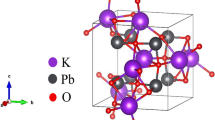Abstract
The FTIR and FT-Raman spectra of Duroquinone have been recorded in the regions 4000–400 and 3500–50 cm–1 respectively. Using the observed FTIR and FT-Raman data, a complete vibrational assignment and analysis of the fundamental modes of the compound has been carried out. The optimum molecular geometry, harmonic vibrational frequencies, infrared intensities and Raman scattering activities, were calculated by the density functional theory (DFT/B3LYP) method with 6-311++G(d, p) basis set. The difference between the observed and scaled wavenumber values of most of the fundamentals is very small. A detailed interpretation of the infrared and Raman spectra of Duroquinone is also reported. The thermodynamic parameters and first hyperpolarizability are calculated using DFT method. The calculated HOMO and LUMO energies show that charge transfer occurs within the molecule.





Similar content being viewed by others
REFERENCES
J. M. Lü, S. V. Rosokha, I. S. Neretin, and J. K. Kochi, J. Am. Chem. Soc. 128, 16708 (2006).
L. I. Smith, Org. Synth.; Coll. 2, 254 (1943).
H. W. Sternberg, R. Markby, and I. Wender, J. Am. Chem. Soc. 80, 1009 (1958).
A. G. Pocinki and R. E. Blankenship, FEBS Lett. 147, 115 (1982).
A. Brunmark and E. Cadenas, Free Radic. Biol. Med. 7, 435 (1989).
B. C. Duffy, PhD Thesis (2012).
M. J. Frisch, G. W. Trucks, H. B. Schlegal, G. W. Trucks, H. B. Schlegel, G. E. Scuseria, M. A. Robb, J. R. Cheeseman, G. Scalmani, V. Barone, B. Mennucci, G. A. Petersson, H. Nakatsuji, M. Caricato, X. Li, et al., Gaussian 09, Revision A.02 (Gaussian Inc., Wallingford CT, 2009).
P. Pulay, G. Fogarasi, G. Pongor, and J. E. Boggs, J. Am. Chem. Soc. 105, 7037 (1983).
G. Rauhut and P. Pulay, J. Phys. Chem. 99, 3093 (1995).
A. Frisch, A. B. Nielson, and A. J. Holder, Gaussview User Manual (Gaussian Inc., Pittsburgh, PA, 2009).
L. N. Wang, X. Q. Wang, G. H. Zhang, et al., J. Cryst. Growth 327, 133 (2011).
G. Fogarasi and P. Puley, Vibrational Spectra and Structure, Ed. by J. R. During (Elsevier, Amsterdam, 1985), Vol. 14, p. 125.
G. Fogarasi, X. Zhou, P. W. Taylor, and P. Puley, J. Am. Chem. Soc. 114, 8191 (1992).
P. Anbarasu, M. Arivazhagan, and V. Balachandran, Indian J. Pure Appl. Phys. 50, 178 (2012).
W. B. Tzeng, K. Narayanan, J. L. Lin, and C. C. Tung, Spectrochim. Acta A 55, 153 (1998).
N. P. G. Roeges, A Guide to the Complete Interpretation of Infrared Spectra of Organic Structures (Wiley, New York, 1994).
D. Sajan, J. Binoy, B. Pradeep, et al., Spectrochim. Acta, Part A 60, 173 (2004).
S. George, Infrared and Raman Characteristics Group Frequencies—Tables and Charts, 3rd ed. (Wiley, Chichester, 2001).
B. Smith, Infrared Spectral Interpretation, A Systematic Approach (CRC, Washington DC, 1999).
P. Ramesh, S. Gunasekaran, and G. R. Ramkumar, Int. J. Curr. Res. Aca. Rev. 3 (11), 117 (2015).
C. Janaki1, E. Sailatha, S. Gunasekaran, and G. R. R. Kumar, Int. J. TechnoChem. Res. 2, 91 (2016).
R. Yankova, S. Genieva, N. Halachev, and G. Dimitrova, J. Mol. Struct. 1106, 82 (2016).
K. Druz bicki, E. Mikuli, and M. D. Ossowska-Chrusciel, Vibr. Spectrosc. 52, 54 (2010).
P. Vennila, M. Govindaraju, G. Venkatesh, and C. Kamal, J. Mol. Struct. 1111, 151 (2016).
S. Ramalingam and S. Periandy, Spectrochim. Acta, A 78, 835 (2011).
D. Sajan, J. Hubert, V. S. Jayakumar, and J. Zaleski, J. Mol. Struct. 785, 43 (2006).
Y. X. Sun, Q. L. Hao, W. X. Wei, et al., J. Mol. Struct.: THEOCHEM 904, 74 (2009).
Sarvendra Kumar, Surbhi, and M. K. Yadav, Asian J. Chem. 29, 2241 (2017).
J. Teotia, S. Kumar, and Surbhi, Asian J. Chem. 28, 2204 (2016).
S. Demir, F. Tinmaz, N. Dege, and I. O. Ilhan, J. Mol. Struct. 1108, 637 (2016).
R. Mathammal, K. Sangeetha, M. Sangeetha, R. Mekala, and S. Gadheeja, J. Mol. Struct. 1120, 1 (2016).
Sarvendra Kumar, Surbhi, and M. K. Yadav, Russ. J. Phys. Chem. B 12, 383 (2018).
A. V. Lobanov and M. Ya. Melnikov, Russ. J. Phys. Chem. B 13, 565 (2019).
ACKNOWLEDGMENTS
The authors acknowledge the financial and technical support from Amity University Noida, India. The authors also acknowledge the technical support from Department of Physics, Jawaharlal University Delhi, India.
Author information
Authors and Affiliations
Corresponding author
Rights and permissions
About this article
Cite this article
Sarvendra Kumar, Surbhi & Yadav, M.K. Optimized Molecular Geometries, Internal Coordinates, Vibrational Analysis, Thermodynamic Properties, First Hyperpolarizability and HOMO–LUMO Analysis of Duroquinone Using Density Functional Theory and Hartree–Fock Method. Russ. J. Phys. Chem. B 15 (Suppl 1), S22–S31 (2021). https://doi.org/10.1134/S1990793121090116
Received:
Revised:
Accepted:
Published:
Issue Date:
DOI: https://doi.org/10.1134/S1990793121090116




